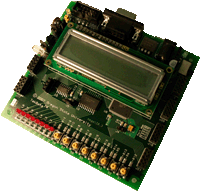Rick Crispo

Embedded System Design
Graduate Coursework:

Made an FM Stereo Alarm Clock with an 8-bit RISC Microcontroller Board.
-Given the hardware, datasheets, skeleton code and class lectures, completed a 10-week lab oriented class to implement an alarm clock.
- I liked the course so much that I volunteered to become the Teaching Assistant the following year.
Wrote C code with GCC tools running on the Linux Ubuntu Operating System and a USB programmer.
The embedded system features:
-
A software debounce routine used with the pushbutton interface.
-
The TWI protocol (I2C) to interface the microcontroller with a room temperature sensor chip. Also, an outdoor temperature sensor is programmed to communicate via TWI over UART so that a long distance wire can be used.
-
A circuit with an encoder knob to set the time, which interfaces to the main program via the SPI protocol.
-
A bi-directional level shifter to interface the 5V microcontroller with a 3.3V FM/AM receiver chip. The two chips communicate with the TWI protocol (the SDA and SCL lines are level shifted).
-
An LCD screen that is used as part of a user interface.
-
A dimmer circuit that adjusts the luminosity of an LED display according to how bright the room is.
-
An external crystal for a timer counter frequency input, which is separate from the main microcontroller clock.
Acronym Definitions
RISC: Reduced Instruction Set Computing; GCC: GNU Compiler Collection; USB: Universal Serial Bus; UART: Universal Asynchronous Receiver Transmitter; TWI: Two Wire Interface; I2C: Inter Integrated Circuit; SPI: Serial Peripheral Interface; SDA: Serial Data Line; SCL: Serial Clock; LCD: Liquid Crystal Display; LED: Light Emitting Diode.